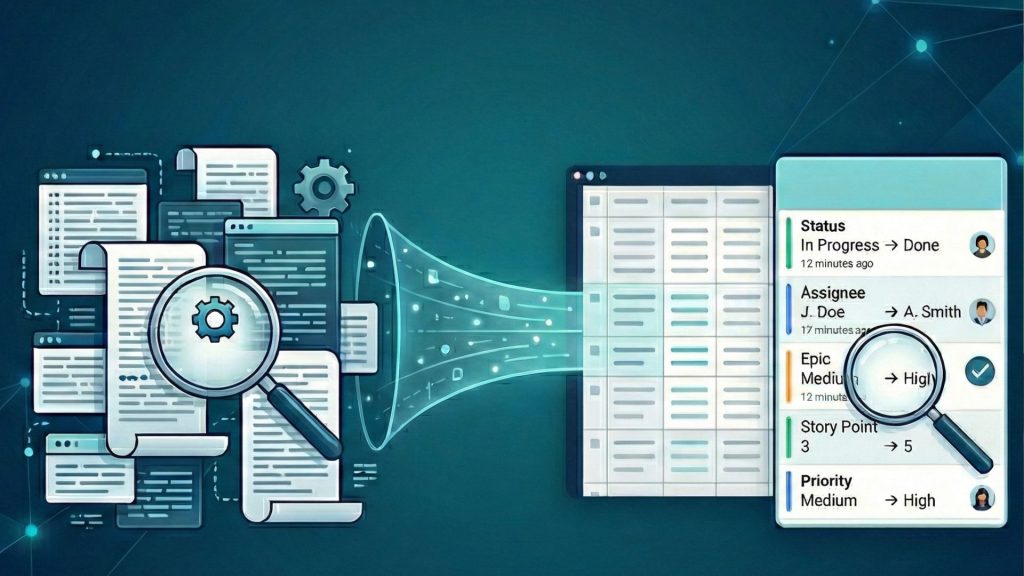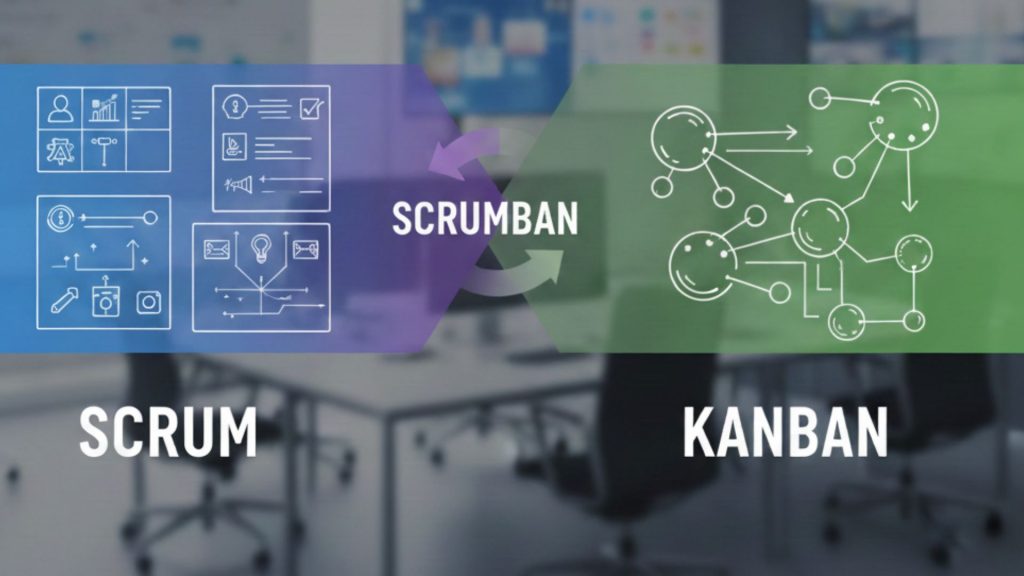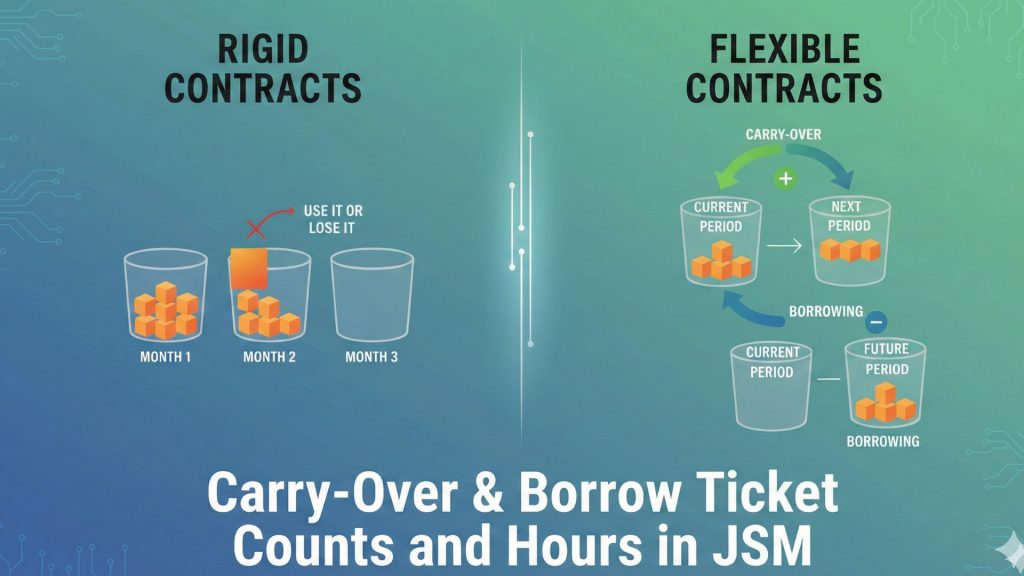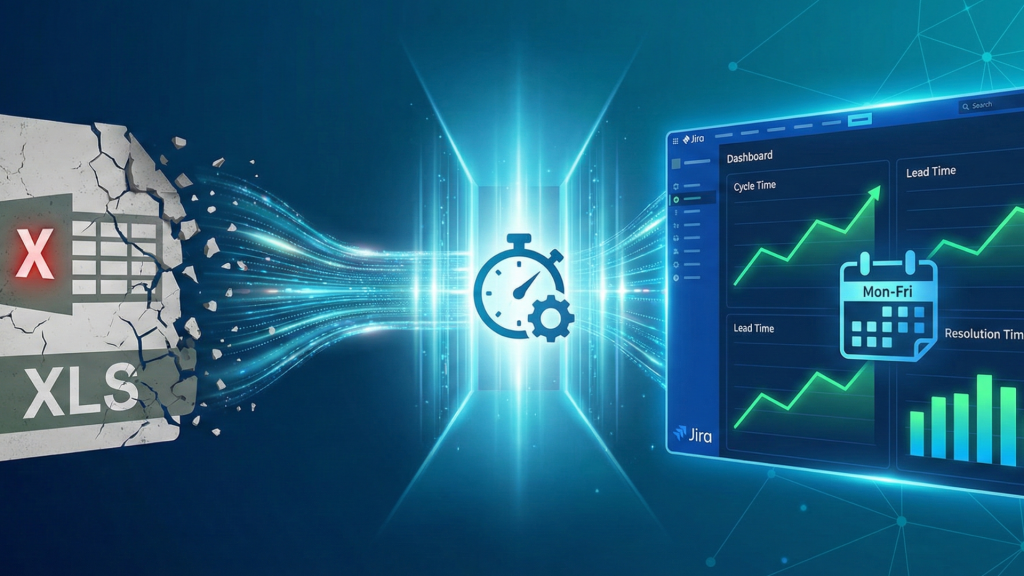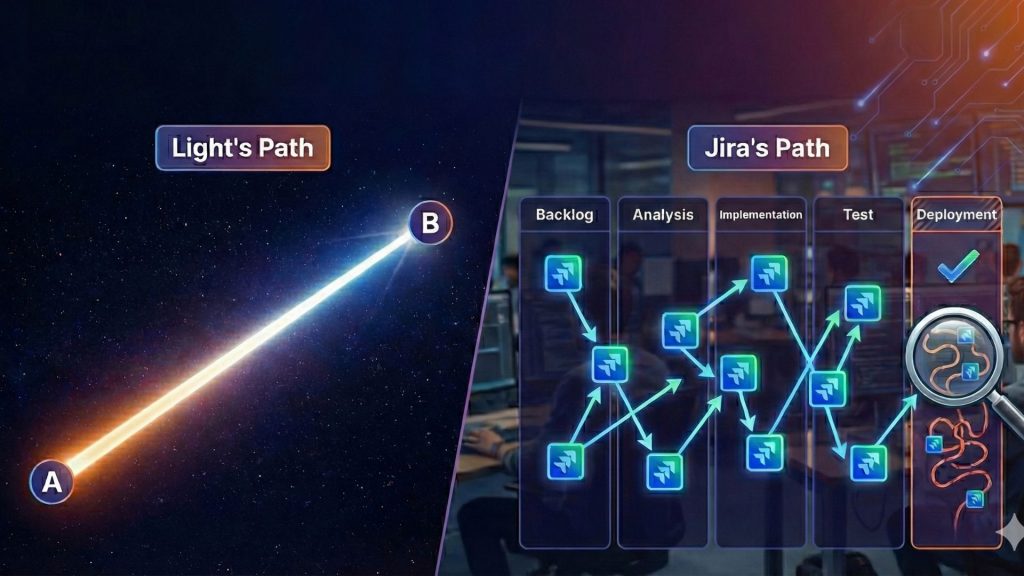A very likely scene: a team celebrates in one part of your building. A major service contract has just been signed, a product of weeks of careful negotiation. It’s filed away, a symbol of a new business relationship.
Pan your camera now. In another part of the building, your service team is in the trenches. They’re facing a flood of support tickets and trying to figure out which is the most urgent. They feel disconnected from the big picture, judged by metrics that don’t always seem to line up with what users actually need.
This gap between the signed document and the day-to-day reality is where service delivery breaks down. It’s where money is wasted, risks are ignored, and customer satisfaction slowly erodes. The problem is that we often treat Service Contract Management and Service Level Agreement (SLA) Management as two separate worlds. Well, they’re not.
In this blog post, we will show you how to connect them. We’ll move beyond descriptions to tell the human story behind these processes and give you a practical blueprint for unifying them.
What Is Service Contract Management?
At its heart, Service Contract Management is the way you manage the entire lifecycle of your service agreements, from the first draft to the final renewal. Think of it as the complete rulebook for a critical business relationship.

This rulebook is comprehensive, covering everything: contract text, negotiation, payment terms, penalties, renewals, duration, and confidentiality. Crucially, it defines the Service Scope and Service Levels, which outline the exact services the vendor will provide and the performance the customer expects.
But here’s the catch: value isn’t created when a contract is signed. It’s created when the service is delivered, day in and day out. And that’s where the rulebook needs more detail.
And What Is a Service Level Agreement (SLA)?
A Service Level Agreement (SLA) is the most important part of that rulebook. It’s a formal promise, written into the contract, that defines exactly what “good service” looks like in clear, measurable terms. If the contract is for the house, the SLA is the detailed blueprint for the systems that make it livable. It turns unclear promises into concrete, trackable commitments. These service levels are typically defined in a few key ways:
Availability & Performance: A promise for a continuous service, like guaranteeing an email service will have 99.9% uptime.
Request Metrics: Targets for request-based services, such as guaranteeing a 15-minute Response Time for high-priority issues and a four-hour Resolution Time. These targets are often tiered, with different times for different request types and severity levels.
Service Quotas: The total amount of service purchased, which can be measured in days, hours, or the number of tickets.
Penalties: A clear understanding of what happens if these promises aren’t met, like service credits or other actions.
How Service Contracts and SLAs Work Together
An SLA is not just related to a service contract; it is a legally binding part of it. The contract sets the overall legal framework, while the SLA provides the specific, measurable performance standards that bring that framework to life.

Managing a contract without actively managing its SLAs is like having a plan with no way to measure progress. This integrated approach is a global best practice, forming the core of frameworks like ITIL (Information Technology Infrastructure Library), the world’s leading guide for IT Service Management. The entire process of Service Level Management is designed to ensure the promises made in contracts are aligned with real-world business needs and are consistently met.
The High Cost of a Disconnected Strategy
When contract management and service delivery operate separately, this creates significant and costly problems for the teams on the ground. Challenges for IT and service delivery teams:
Misleading Performance Metrics
Teams often face a frustrating paradox: their dashboards show they are meeting all their operational SLA targets, but business users are still unhappy with the service. This happens when SLAs measure internal processes (like ticket resolution time) instead of the actual business outcomes or the quality of the user’s experience.
Outdated and Irrelevant Goals
Service teams are frequently stuck managing inherited SLAs that no longer reflect current business priorities. This forces them to focus on metrics that don’t deliver real value, simply because “it’s in the agreement.”
Difficult and Manual Reporting
Generating meaningful reports is often a manual, time-consuming task. IT managers have to extract raw data and build complex reports in spreadsheets because native service desk tools lack the flexibility to account for business context or provide strategic insights.
Challenges for Contract and Operations Managers
Lack of Performance Visibility
Contract managers are responsible for vendor performance, but often have no direct access to the real-time data needed to measure it. Most of the time, they see the state of an individual request or an individual service, but they can’t see the big picture over the long term. This critical information is typically locked away in the IT team’s service desk system, creating a massive blind spot.
Inefficient Manual Tracking
Without a unified system, managers are forced to rely on disorganized spreadsheets, shared drives, and email threads to track contract milestones and obligations. This is a process that is inefficient and highly prone to human error.
Significant Contractual Risk
This lack of visibility and reliance on manual processes creates serious business risks. An underperforming contract might be automatically renewed simply because there is no hard data available to justify termination or renegotiation.
How to Bridge the Gap: 4 Human-Centered Practices
Unifying your approach doesn’t require a massive overhaul. It starts with a shift in mindset and a commitment to a few key practices.
Get Everyone on the Same Page: The first step is to create a single source of truth. When all your contracts and performance data live in one central, accessible place, you break down the walls between departments. This eliminates the guesswork and ensures everyone is working from the same information.
Design Your Promises, Together: An SLA should never be created in a vacuum. The most effective agreements are born from collaboration between IT teams, business leaders, and even end-users. This ensures the promises you make are both technically feasible and genuinely valuable to the business.
Let Technology Do the Heavy Lifting: Manually tracking performance in spreadsheets is a recipe for burnout and human error. Automating your monitoring and reporting frees up your talented people to focus on strategic improvements instead of boring administrative work. It allows you to be proactive, spotting potential issues before they become breaches.
Treat Agreements as Living Documents: Your business is constantly evolving, and your agreements should, too. Schedule regular reviews of your SLAs to ensure they still align with your strategic goals.
Putting It All into Practice in Jira Service Management
For thousands of teams, Jira Service Management (JSM) is where the work happens. It’s the system of record for service requests, incidents, and problems. But when it comes to unifying contract and SLA management, it’s important to understand what Jira does well, and where its natural limitations are.

What Jira Service Management Can Do:
Jira is powerful for operational service management. You can:
Manage Workflows: Create distinct workflows for service requests, incidents, problems, and change requests.
Track SLAs: Use built-in SLA timers to set and measure time-based targets for individual tickets.
Log Work: Allow agents to log the hours they spend on a customer’s request.
What Jira Service Management Can’t Do
As you scale, the manual effort required to connect the dots becomes a real burden. JSM on its own can’t:
Define Contracts
There is no native way to define customers, their contracts, clauses, service periods, or the specific quotas for each term.
Show Long-Term Performance
Native reports show individual SLA success, but they don’t easily show you the long-term performance trends divided by weeks, months, or years against a contract’s targets.
Track Quotas
It cannot show you an agreed-upon quota (e.g., 200 hours per month) and how much of that quota has been used.
Provide a Unified View
Both customers on the portal and agents in the ticket view lack a simple, consolidated way to see contract details and quota consumption in real-time.
To truly build a bridge, you need to bring the business context of the service contract directly into the Jira environment.
Introducing TicketBook: The Bridge for Your Teams in Jira
This is exactly why purpose-built apps like OBSS’s TicketBook – Service Contract Management for Jira exist. It’s designed to solve these specific problems by giving each team exactly what they need. TicketBook is built to bridge the gap from both sides of the table. Whether you are a customer holding your vendors accountable to their promises or a service provider managing multiple customer contracts, the app provides a unified platform for tracking performance and quotas. It creates a single source of truth that serves both the buyer and the seller, ensuring everyone is working from the same data.

TicketBook For the Contract Manager
TicketBook gives you the visibility you’ve been missing. You can define contracts, clauses, and service periods directly inside Jira Service Management. You can set:
SLA Targets: Define target success rates for your metrics (e.g., 99.5% success rate for response time SLAs).
Ticket & Hour Quotas: Set specific quotas for service requests (e.g., 50 normal and 5 high-priority requests per month) or service hours (e.g., 200 hours per month).
Moreover, you can define multiple targets of each type for different services under a single contract.
Flexible Quota Adjustments: Handle real-world scenarios by defining additional quotas sold for specific periods (for example, a customer purchasing 100 extra requests for December) or logging quota consumption from out-of-system work, like a separate project that needs to be billed against the main contract.
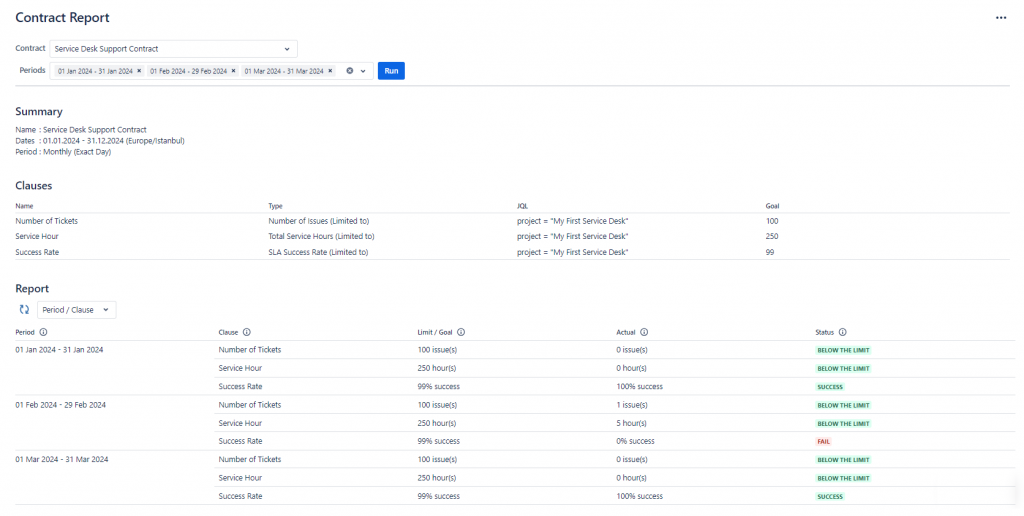
With a single dashboard, you can easily report on purchased vs. used quotas for each contract period and instantly identify any breaches. This means you can hold vendors accountable with hard data, make informed decisions at renewal time, and eliminate the risk of overspending.
TicketBook For the IT Manager
TicketBook provides the flexible, powerful SLA reports you need to tell the true story of your team’s performance. You can move beyond simple pass/fail metrics and generate reports on SLA success rates grouped by customer, contract, or project, and analyze trends over weeks, months, or years. This allows you to provide the business-centric insights that leadership actually wants to see, proving your value and showing how your team’s efforts align with the company’s most important agreements.

When your contracts and your service operations live in the same system, you unlock three powerful advantages. Here are the advantages of a truly unified system:
A Single Source of Truth: The service requests and worklogs are in Jira, and now the contract lives there too, with clauses directly linked to the work items. No more hunting for documents or questioning data.
Total Transparency: The service manager, agents, and even customers can all see the same data and reports, ensuring everyone is aligned. Agents can see a customer’s monthly quota and how much has been used directly on the ticket view screen. At the same time, customers can see their own quota usage in their customer portal.
Fast Communication: Any notes or updates added to the contract by a manager are instantly visible to agents on every relevant ticket, closing the communication loop. This prevents critical errors, such as an agent continuing to work on requests after a contract has expired or, conversely, stopping work when a customer has purchased an additional quota.
Ready to close the gap between your contracts and your service desk for good? See how TicketBook can turn your Jira instance into a powerful, integrated contract management engine. Here, you can also book a online demo to see it in action.
